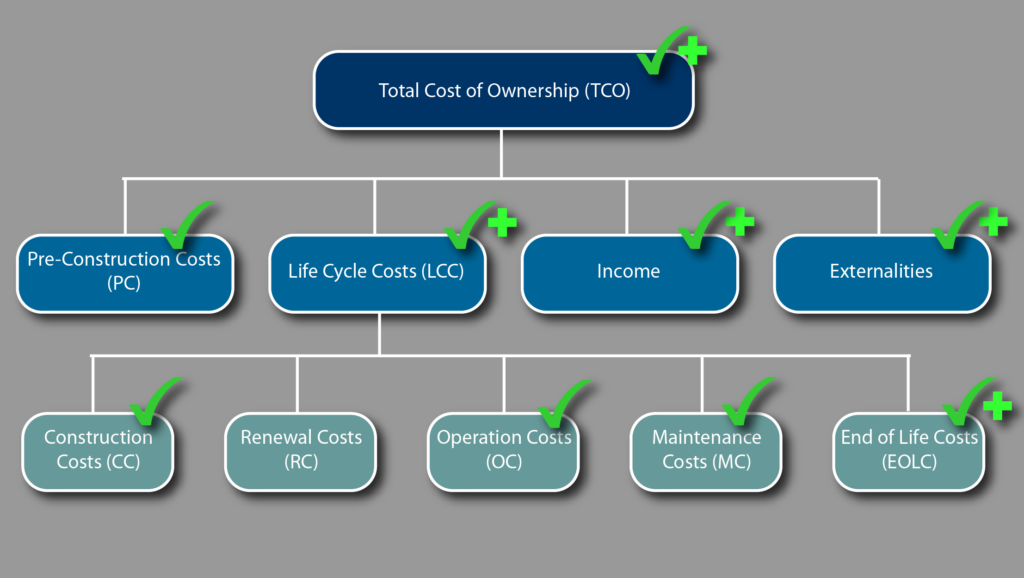Controlling Costs for Long-term Profit
SunFarmor generators shine when you compare their costs with those of alternatives across the entire life cycle. Calculating the total cost of ownership reveals hidden costs to mitigate risk, allowing you to make an informed decision to secure long-term profits. Here’s a breakdown of the Total Cost of Ownership of a solar farm.

Pre-Construction Costs
These payments cover land costs and the soft costs of engineering, design, and licensing typically handled by an EPC (Engineering Procurement and Construction contractor). A typical solar farm using foundations (concrete, driven piles, soil screws) for the racking requires the same costly and time-consuming activities a building does. First, surveyors document the land and then geotechnical engineers test the subsoil. Engineers then use the data to design a customized layout including a perimeter fence and access roads required to build the racking in place.
SunFarmor generators do away with all these preconstruction costs and delays. There are no foundations, surveys, geotechnical tests, fences, or access roads – only a staging area where crews assemble pre-engineered SunFarmor generators that are towed to the field and cabled together. Time requirements and soft costs drop dramatically.
Life Cycle Costs
These payments include first costs, recurring costs, replacement costs, and disposal costs.
Construction Costs
These payments comprise the majority of the CAPEX. They include all labor, materials, and equipment costs required to construct the solar farm, including the EPC’s overhead and profit charges. The payments also include costs for temporary facilities like portable toilets, dumpsters, and generators. Since traditional solar farms are built piece by piece in the field, often by hand, labor costs are comprising larger percentages of the CAPEX. Since the IRA’s tax credits require prevailing wage labor, cheap labor is no longer an option.
SunFarmor generators trade an increase in material for a dramatic decrease in labor while improving quality control and dramatically increasing throughput.
Maintenance Costs
These recurring costs for labor and material ensure the solar farm performs as expected. These include both corrective repairs and preventative maintenance. Since most solar farms rely on moving trackers installed close to the ground to reduce wind loading, they require constant upkeep of the moving parts and the vegetation.
SunFarmor generators have no moving parts to maintain, and their reflectors hover well above ground vegetation, minimizing maintenance costs. After a snowfall, maintenance workers don’t need to clear snow by hand or by rotating the tracker. The heat from the SunFarmor generator’s increased backside production melts the snow naturally.
Operation Costs
The OPEX payments are for administrative monitoring, rent, insurance, energy self-consumed to power trackers, and recurring regulatory inspection costs, taxes, and charges. Since SunFarmor generators have no moving parts, they minimize OPEX costs.
Renewal Costs
The most vulnerable component of any solar farm is the power electronics that deliver alternating current to equipment or the grid. Most solar farms plan to rehabilitate or replace their inverters during the midlife of the PV panels. A SunFarmor generator solar farm will be no different but avoids exposure to other costly midlife repairs like those to bearings or motors.
End-of-Life Costs
These costs are where SunFarmor generators outperform all competitors. Racking manufacturers design their products for the life of the PV panels, which is typically 25 to 30 years. At the end of life, crews decommission solar farms by removing all components in the field, including foundations, while returning the land to its prior state. The decommissioning costs include demolition, inspections, and transportation, less any salvage value from recyclable components. These costs are hidden from most solar farm owners since few EPCs have experience with decommissioning contemporary solar farms.
Since the chassis of SunFarmor generators are designed for a 60-year life, they can be repowered instead of decommissioned. Crews can tow each SunFarmor generator to a staging area and swap new PV tables, repeating the original installation process before towing them back into position in the field. This reuse dramatically reduces the life cycle cost of a solar farm comprised of SunFamor generators.
Income
Every solar farm can earn income from the power it produces. But SunFarmor generator owners can use them to power equipment that unlocks new revenue streams. For instance, a row crop farmer can use SunFarmor’s clean electricity to make their own carbon-free fuel and fertilizer on their farm, allowing them to earn price premiums for growing and drying carbon-reduced grain. Dairy and hog farmers can use SunFarmor generators to power their barns to dramatically reduce the carbon footprint of their products, too.
Externalities
Any solar farm will avoid the negative externalities, or unpaid costs, of releasing carbon into the atmosphere. But owners of SunFarmor generators can create positive externalities, or unpaid benefits, for their local economies by using local energy to create local wealth. We designed SunFarmor generators to avoid the bottlenecks of centralized production, opting instead for distributed manufacturing which creates 43 local job years from every 4MW constructed. These benefits are most important for policy makers interested in promoting an equitable energy transition.